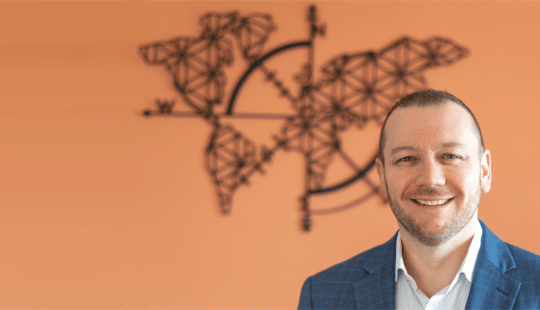A conversation with Satpal Biant, Head of Public Sector, SAP and Michael Esau, Global HR Advisor, SAP
Anyone who has ever undergone a major technology implementation realises, often too late, that cultural transformation goes hand-in-hand with any digital transformation. With more than 20 years of experience helping individuals and organisations achieve peak performance, including spending the last ten years in global HR Advisory roles for SAP, Michael Esau has seen and helped organisations manage a fair share of organisational changes. The most significant of those changes has likely been the way technology has transformed the way organisations operate, collaborate, and communicate.
Recently, Michael sat down with Satpal Biant, Head of Public Sector at SAP UK & Ireland, to discuss how organisations like those in the UK public sector who are currently implementing the Shared Services Strategy, can get employees onboard from the outset and how organisations can use the process of digital transformation to their advantage – to identify outdated processes and identify where automation and collaboration can create a more productive, efficient and successful organisation.
Satpal: Michael, we’ve both been in the trenches on many major digital transformation programmes in the Public Sector; from a people-perspective, what do you think is the essential starting point when guiding a customer through the SAP transformation journey?
Michael: The most fundamental thing for organisational leaders to do is to set that North Star; to know how you want the technology to work for you and your organisation. For example, if a department is considering implementing new HR processes, it should be thinking about its end-goals like making onboarding journeys straightforward, as well as making the workplace a great place to learn, grow and perform well for existing employees.
Technology transformation should be ‘bottom-up’ rather than ‘top-down’. Of course, the initial pressure to change may come from the top – the Shared Services Strategy for Government is a good example of this. But the execution of change must be done with a people-first mindset, with buy-in from all stakeholders.
So, when we look at organisational change, we work with our clients to answer four key questions:
- What is humanly desirable? In other words, what does the organisation want to achieve and change?
- Is what we want to change organisationally doable when considering the operating model, the proposition and the existing team and hiring requirements?
- Is it technologically feasible? For example, is there the data integration capability needed?
- Finally, is a transformation economically viable?
Fundamentally, organisations must be clear on the final destination – the North Star. The technology is just there to enable that change to happen.
Satpal: That organisational transformation can be difficult to navigate, especially when an organisation has never gone through such a fundamental and systematic change.
This is especially true of many public sector organisations. In the past, Government technology transformation was often focused on the front end, user-interface experience, without touching the legacy back-end systems. But now with the UK’s Shared Services Strategy, that change needs to be implemented end-to-end. How do we help customers, particularly in the public sector, feel comfortable taking that leap?
Michael: One of the key things that makes SAP a transformation partner of choice is that we respect our customers need for consultation and flexibility. Many of our competitors offer one-size-fits-all solutions, but because our solutions are modular, organisations can – I suppose – ‘bite the elephant’ rather than eating the whole thing at once. Their rollout is fully customisable, and they can remain agile, which is important from a proposition perspective.
Satpal: That’s true – many of our partners have told us that our flexible implementation process has helped their organisations adopt a culture of agility. People often view digital transformation as moving from fixed state A to fixed state B – which is a legacy transformation mindset. It’s actually a change from where you are now, to a position where you can be adapting to new requirements. It is a significant mindset shift though, and presumably that new mindset is a big factor in those initial discussions.
Michael: We don’t assume that customers have experienced transformations like this in the past, so we take the time to share the key considerations that underpin the change and the decisions required to get ready to execute the change –
When embarking on a change or transformation, knowing that the organisation is committed to change is super important. Needing to change versus committing fully to change are two separate things. We advise customers to identify who will be impacted by the change – which stakeholders are involved. We discuss the changes with those stakeholders, ensuring everyone understands and is committed. But we don’t stop there, we provide powerful business process intelligence to show end users how the processes they use today will change in the future, well in advance of any technology being deployed, we call this simulating the change. The benefits of this unique approach can be significant, from reduced cost on change management right through to de-risking the transformation programme.
The other part of driving customer success is by looking 5 years ahead. A major piece of advice to all of our customers is to work backwards from the desired outcomes. How will the organisation know it is making the desired progress, is moving the needle in the right areas and progressing as planned Advising customers to think about the change considerations and rigorously applying them, is vitally important to the attainment of any change programme.
Satpal: Ensuring that buy-in, again, from the bottom-up is so critical to a successful transformation. Some of our customers choose to capture employee sentiment in tools like SAP Qualtrics throughout their technology change programme as well. This is a powerful way to reduce resistance to solution adoption that can hamper implementations, and ensure employee satisfaction with their day-to-day technology and IT support processes. Our collective experiences over the last few years has also made that stakeholder commitment easier in some ways as most people know that a cloud transition can enable new, better ways of working. SAP’s transformations not only change the emphasis of work – building processes around collaboration and communication – but also enable hybrid working. It’s easier to secure staff buy-in because they realise it will enable them to do all the things they could do before, but with less complexity and with new capabilities to manage data and stay secure, as well as to work more flexibly.
Michael: The transformation can be an empowering and a positive cultural change. A lot of public sector organisations have technology that can’t be operated remotely, meaning large groups of people always had to be in the office. By enabling people to work remotely you are challenging existing practices and preparing leaders for the future of work, by helping them build trust with employees who have been given greater flexibility and freedom.
Satpal: …and using technology to lay that foundation for agility and embracing the future of work is often the real North Star in all of this. We’ve always been about people, process, outcomes, and working backwards from what the customer wants to achieve. Technology is almost the easiest part because culture sits around that. But the role of the leader and the employee in the long term? That is the most important success factor, and that is why we spend so much time coaching organisations to feel confident in their motivations and goals.



